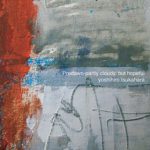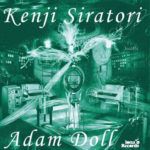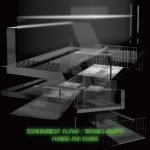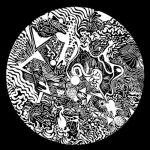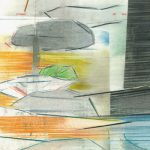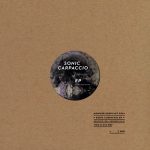Eke
11,00 € VAT Included
Only 2 left in stock
kazushige kinoshita : violin
yoichiro shin?Fmetals
recorded on 10, May 2003
“Textures produced with silences and non-traditional instruments are the points of congruence for these Canadian and Japanese sessions. Drawing on the timbres that arise from mixing percussion, turntables and electronics, Toronto-based Mike Hansen and Tomasz Krakowiak have come up with a CD as engaging as their earlier collaboration with British reedist John Butcher.
The shorter CDRs of Kazushige Kinoshita on violin and Yoichiro Shin on metals, plus laptopper Taku Unami’s meeting with Briton Mark Wastell, who plays amplified textures rather than his usual cello, are even more reductionist. They seems to take On-kyo to its furthest extreme — with the amount of silence outstripping almost any noise on the discs.
In contrast to EQUATION (Spool/Field SPF 303) with Butcher, where the drummer seemed to fade into the background, Krakowiak’s work is much more prominent here. The third track, for instance, begins with cymbal rolls and extended kit squeaks that escalate to snaps and cracks from lightly stroked wood, plus a single bell peal. Meanwhile electronics — likely manipulated by Hansen — add the rubbing of metallic tabletop patterns and an assembly line of brief clicks to the showcase. With an ending featuring a resonation that sounds as if it comes from a slinky vying meeting up with wavering sine waves, you can’t be sure where to ascribe the shrill protracted shrieks — maybe it’s an amp cranked up to too high a volume.
This piece and the two earlier ones, which expose the grinding of turntable motors and what appears to be Krakowiak sandpapering his drum top, not to mention less clearly defined tones, establish the strength of the more-than-25-minute final track.
Both electronic and acoustic instruments get a workout here as steady thunder from a kettle or upright bass drum first complement intonations that could be made by a fan belt slipping off a motor, then are amplified through a piano’s internal speaking length. Minidisks and live sampling provide the subsequent rumble and buzz, as if overloaded circuits have been surmounted by unidentified items rotating on a turntable.
Soon bolo bat-like pops echo on the surface of a ride cymbal, gradually decreasing in speed to well-spaced beats, amplified by a hollow, cylindrical tool. At the same time electronic oscillations are replaced by the gibberish produced when vinyl records are spun backwards at different speeds. After the sound is further intensified by the scratch of an e-bow on a ride cymbal top, drum thwacks and riveting frog-like lowing add to the miasma, then dissolve into echoing didjeridoo-like pitches.
In contrast to Hansen and Krakowiak’s continual electro-acoustic resonance, Kinoshita and Shin not only drift far away from common instrumental timbres but also separate the pitches that do appear with prolonged silences. Often the quiet lasts for 15 or 20 seconds at a stretch, with sound only heard for nanoseconds.
Kinoshita, who wrests fleeting pitches from his fiddle by lying it flat on his lap while applying maximum pressure with a half-size bow, often appears to be patting or scraping his strings. Other times, strokes that resemble guitar-like flat picks appear, as do what’s evidentially the string being gradually loosened from their tuning pegs. With these tones usually appearing one at a time, another sound similarity could be to the motion of hollow pinball flippers.
In response Shin, whose “metals” are presumably a single cymbal and a laptop, moves between definite mini scratches on the cymbal top to full-force reverberating metal shakes — as the sounds are often multiplied by the computer.
With much of the so-called action taking place almost out of earshot, the listener has time to concentrate on each of the noises when they do appear; although more time to savour them may have been a better strategy. Thus when the bird-like chirrup of single pressured string is succeeded shortly after the midway point by a full force undulation of many scraped strings, it’s as if a massed trumpet fanfare has been heard in a still clearing. Answering cymbal scrapes seem to bring out brief col legno taps.
By the end of the track, these quick sound sources have escalated to what the two probably see as an all-out noise coda — since the cymbals rustles and strings squeaks arrive only five seconds apart before the final peep fades away to nothing.
Then again, EKE could be Black Sabbath’s PARANOID when compared to SMALL SOUNDS IN A QUIET ROUND (sic). Operating on the farthest reaches of On-kyo, Wastell and Unami’s slightly more than 19½-minute disk is practically noiseless.
Although it begins with what could be a door slam and a fist hitting a solid object, the breaks that pierce the silence after that are no louder — and no longer — than what is produced by a nutcracker’s snap, a crabwalk on metal or bird claw scratches. In the penultimate minute two brief undulating whistles appear as does a seconds-long sweep across the sound field. Don’t play this CD in a noisy room, even with earphone it would be like listening to nullity.
There are those who may think that Wastell and Unami have taken the sounds of non silence beyond human hearing, although committed On-kyo fanciers may hold a differing view. Even most followers of experimental improv would be more satisfied with EKE and RELAY in ascending order of preference.”
KW





